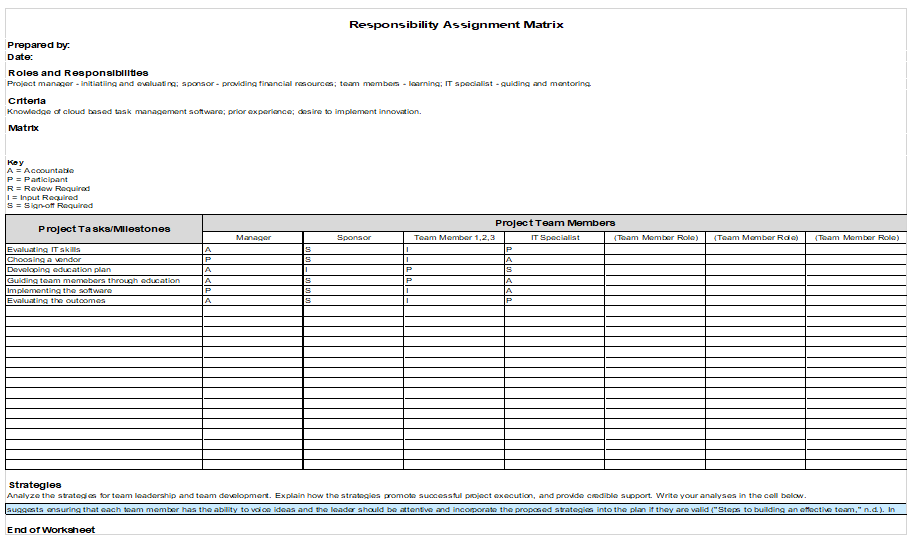The Appendix presents the staffing plan and individuals responsible for each aspect of this project in the form of the Roles and Responsibilities Matrix (RAM). Several criteria can be applied to choose the appropriate candidate for the role of information technology professional because prior experience mentoring or coaching teams is vital for this project. Other team members will be chosen based on their basic level of understanding the purpose and use of (Cloud Based Task Management) CBTM. The assumptions on which the RAM is based include the number of staff members available at the time of execution and ability to hire new personnel before the implementation of CBTM. This paper will provide an assessment of baseline management and best practices regarding leadership that will help ensure success.
Table 1 presents the assessment of the roles and responsibilities of each team member. Team leadership strategies that promote successful project execution include forming a vision, developing approaches that engage each team member into voiding ideas, and offering innovational strategies. Petty (2019) recommends forming a unified vision and strategy for the project and communicating it to the stakeholders; in this case, team members and IT professionals. Additionally, team building activities, for instance, brainstorming can be applied to improve cooperation.
In general, a leader of this CBTM project has to adjust his or her approach to the requirements and preferences of the team members. It is necessary to ensure success because the staff will have to go to an educational program and to ensure success all individuals must acquire an adequate level of information technology skills and understanding (Westland, 2016). It can be argued that the only approach to achieving this is to continuously evaluate the project’s implementation process and adjust the approaches to its execution. Also, properly managing relationships within the teams and examining this element is both a logical approach to leadership and strategy for determining the outcomes (Cardinal, 2015). The chosen strategies support the successful implementation of the project because they value the input of each team member and incorporate approaches to managing changes within the identified deadlines.
Team development can be facilitated by applying Tuckman’s five stages. The following – “forming, storming, norming, performing, and adjourning” describe the various transformations that the team will experience throughout this project (Healthfield, 2018, para. 5). The ability to approach each stage adequately, for instance, providing orientation and adequate explanation of the project at the forming stage is the key to successful implementation. Several criteria can be used to evaluate the proposed plan and establish changes to it, for instance, identifying whether the plan reflects the actual availability of financial and human resources in a company is necessary.
Additionally, the perceived usefulness of the CBTS application evaluation can be leveraged to determine whether the educational program achieved the goal of explaining the usefulness of the new approach. Overall, this paper presents the RAM for the CBTM software and defines approaches to leadership and team management, which will help ensure that each staff member has a good level of knowledge and capabilities of using the proposed applications in the future.
References
Cardinal, R. (2015). 5 steps to building an effective team. Huffington Post.
Heathfield, S. (2018). 5 stages of team development.
Petty, A. (2019). Three leadership hacks to accelerate success in an era of change. Web.
Westland, J. (2016). What is project leadership?. Web.
The Appendix
